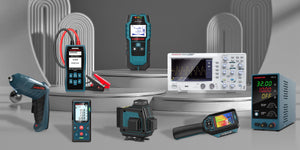
How to Choose an Oscilloscope: A Complete Buying Guide
How to Choose the Right Oscilloscope for Your Projects
Hanmatek Oscilloscope Buying Guide
What Is an Oscilloscope?
An oscilloscope is an essential tool for electronic testing, used to observe and analyze electrical signal waveforms. Whether you're debugging circuits, developing embedded systems, teaching electronics, or working on DIY experiments, an oscilloscope is key to improving both efficiency and accuracy.
Key Specifications to Understand Before Buying:
Bandwidth
Determines the highest frequency signal the oscilloscope can accurately capture. Recommended: Bandwidth ≥ 5× the frequency of the signal being measured.
Sampling Rate
Affects how accurately the oscilloscope can reproduce signal waveforms. Recommended: Sampling rate ≥ 5–10× the signal frequency.
Number of Channels
2 channels are ideal for basic signal observation. 4 channels are suitable for comparing multiple signals simultaneously.
Digital vs. Analog Oscilloscopes
| Type | Digital Oscilloscope | Analog Oscilloscope |
|---|---|---|
| Advantages | High-resolution display, data storage, versatile features | Fast response, simple structure |
| Recommended Use | R&D, maintenance, teaching, DIY | Basic demonstrations in education |
Model Recommendations by Use Case
| Application | Recommended Specs | Suggested Model |
|---|---|---|
| Education / Labs | 60–100 MHz, 2 channels | Hanmatek DOS1062 |
| Industrial / Engineering | ≥100 MHz, 4 channels | Hanmatek DOS1102 |
| DIY / Hobbyist | 60–70 MHz, portable | Hanmatek HO11, HO102S |
Hanmatek Oscilloscope Product Lineup
Hanmatek offers a variety of high-performance digital oscilloscopes designed for education, repair, industry, and development. Below is a comparison of our main models to help you find the right tool for your needs:
| Model | Bandwidth | Sampling Rate | Channels | Display | Key Features |
|---|---|---|---|---|---|
| DOS1102 | 100 MHz | 1 GSa/s | 2 | 7-inch color | Reliable and stable; ideal for engineers and R&D |
| DOS1102S | 100 MHz | 1 GSa/s | 2 | 7-inch color | Enhanced version with USB storage and more auto features |
| DOS1104 | 100 MHz | 1 GSa/s | 4 | 7-inch color | 4-channel sync analysis; perfect for complex circuits |
| DOS1202 | 200 MHz | 1 GSa/s | 2 | 7-inch color | Higher bandwidth for high-speed signal testing |
You can explore the full range of Hanmatek benchtop oscilloscopes directly on our official store. Click here to view and purchase Hanmatek oscilloscopes .
Why Choose Hanmatek Oscilloscopes?
- Excellent value for money: Professional-grade performance at a competitive price
- Versatile lineup: From 2 to 4 channels, 100 MHz to 200 MHz, covering all skill levels
- Portable and practical: Compact design ideal for both benchtop and field use
- User-friendly: Simple menus, multiple language support, and easy operation
Conclusion
Choosing the right oscilloscope not only speeds up troubleshooting but also boosts your confidence in R&D, teaching, or repair work. Hanmatek is committed to providing reliable, precise, and user-friendly test instruments—trusted by engineers, educators, and hobbyists alike.
Ready to upgrade your lab or workspace? Choose Hanmatek and start debugging with confidence. Need help picking the right model? Contact us or visit our official website for more details and technical support.




Dejar un comentario